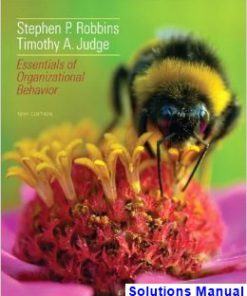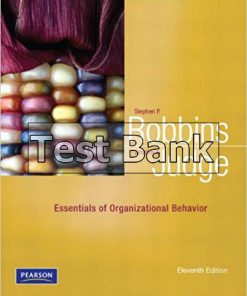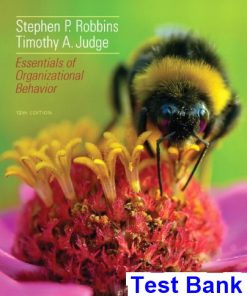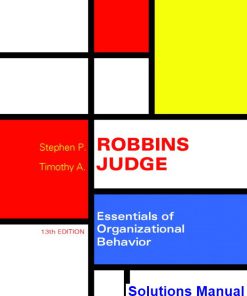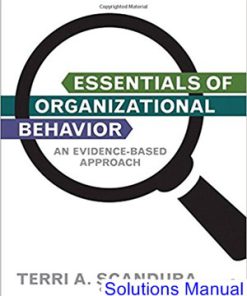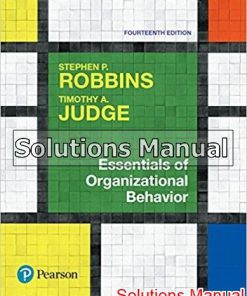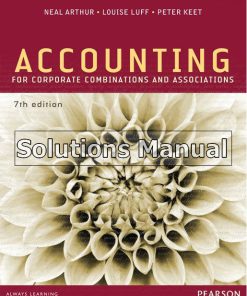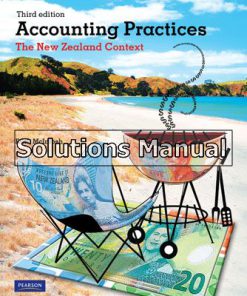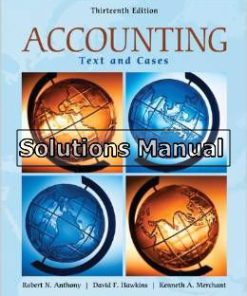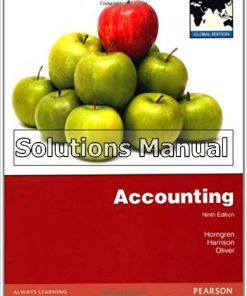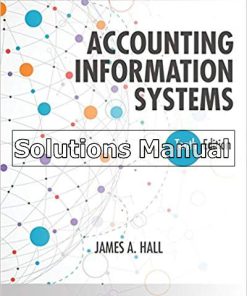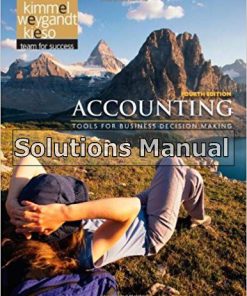Essentials of Organizational Behavior 2nd Edition Scandura Solutions Manual
$26.99$50.00 (-46%)
Essentials of Organizational Behavior 2nd Edition Scandura Solutions Manual.
You may also like
This is completed downloadable of Essentials of Organizational Behavior 2nd Edition Scandura Solutions Manual
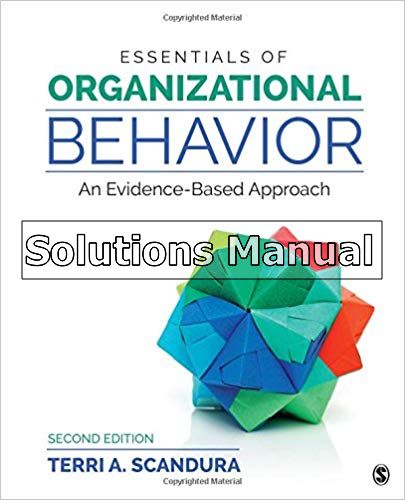
Product Details:
- ISBN-10 : 1506388469
- ISBN-13 : 978-1506388465
- Author: Terri A. Scandura
Concise, practical, and based on the best available research, Essentials of Organizational Behavior: An Evidence-Based Approach, Second Edition equips students with the necessary skills to become effective leaders and managers. Author Terri A. Scandura uses an evidence-based approach to introduce students to new models proven to enhance the well-being, motivation, and productivity of people in the work place. Experiential exercises, self-assessments, and a variety of real-world cases and examples provide students with ample opportunity to apply OB concepts and hone their critical thinking abilities.
Table of Content:
PrefaceAcknowledgmentsAbout the Author
Section I: Introduction
Chapter 1: What is Organizational Behavior? Chapter Learning Objectives A Crisis of Leadership? What is Organizational Behavior? Evidence-Based Management What is Critical Thinking? The Scientific Method Outcome Variables in Organizational Behavior Levels of Analysis in Organizational Behavior How OB Research Increases Employee Performance Theory X and Theory Y Plan for This Textbook Leadership Implications: Thinking Critically Key Terms Toolkit Activity 1.1: Personal Leadership Development Plan Case Study 1.1: Organizational Science in The Real World Self-Assessment 1.1: Are You Theory X Or Theory Y? Self-Assessment 1.2: Assessing Your Experiential Evidence BaseSection II: Understanding Individuals in Organizations
Chapter 2: Personality and Person-Environment Fit Chapter Learning Objectives The Right Stuff at the Wrong Time? What is Personality? Myer-Briggs Type Indicator “The Big Five� Personality Traits and Health Research Other Relevant Personality Traits Psychological Capital Core-Self Evaluations Person-Environment Fit Leadership Implications: Understanding Others Key Terms Toolkit Activity 2.1: Fitting In Somewhere Great! Case Study 2.1: Who Would You Hire? Self-Assessment 2.1: The Big Five Personality Test Self-Assessment 2.2: Type A/Type B Behavior Pattern Self-Assessment 2.3: Core Self-Evaluations Assessment
Chapter 3: Emotions and Moods Chapter Learning Objectives Does Lack of Sleep Make You Grumpy? Emotions and Moods at Work Affective Events Theory: An Organizing Framework Affective Climate Moods Emotional Labor Emotional Intelligence Emotional Contagion Affective Neuroscience Leadership Implications: Affective Coaching Key Terms Toolkit Activity 3.1: The 5-Minute Gratitude Exercise Case Study 3.1: Managing Your Boss’s Moods And Emotions Self-Assessment 3.1: Positive and Negative Affect Schedule (PANAS) Self-Assessment 3.2: Emotion Regulation Questionnaire (ERQ)
Chapter 4: Attitudes and Job Satisfaction Chapter Learning Objectives Job Satisfaction: An Upward Trend What is an Attitude? Do Attitudes Matter? Job Satisfaction Job Search Attitudes Organizational Commitment Perceived Organizational Support Psychological Empowerment Leadership Implications: Creating Meaning at Work Key Terms Toolkit Activity 4.1: What Do Workers Want From Their Jobs? Case Study 4.1: A Crisis In Nursing Self-Assessment 4.1: How Much Career Adaptability Do You Have? Self-Assessment 4.2: Do You Experience Empowerment?
Chapter 5: Perception, Decision Making, and Problem Solving Chapter Learning Objectives Would You Be Happier If You Were Richer? Understanding Why People Don’t See Eye to Eye Employability: Self-Fulfilling Prophecies During the Application Process Individual Decision Making The Rational Decision-Making Model Prospect Theory Intuition Decision Traps Creative Problem Solving Leadership Implications: Making Ethical Decisions Key Terms Toolkit Activity 5.1: The Oil Drilling Partnership Case Study 5.1: Do You Have To Spend Money To Make Money? Self-Assessment 5.1: Employability – Perceptions Of Prospective Employers Self-Assessment 5.2: How Would You Rate Your Creativity?Section III: Influencing and Motivating Employees
Chapter 6: Leadership Chapter Learning Objectives Have Leaders Lost Their Followers’ Trust? What is Leadership? Trait Approaches Leader Behaviors Path-Goal Theory Leader-Member Exchange The Importance of Trust Full-Range Leadership Development Moral Approaches Critiques of Leadership Theory Leadership Implications: Flexibility Matters Key Terms Toolkit Activity 6.1: Applying the Full-Range Leadership Development Model Toolkit Activity 6.2: Comparing Supervisor Leader–Member Exchange Case Study 6.1: Which Boss Would You Rather Work For? Self-Assessment 6.1: Mentoring Functions Questionnaire (MFQ-9) Self-Assessment 6.2: How Trustful Are You?
Chapter 7: Power and Politics Chapter Learning Objectives What is it Like to Have Power? Power and Influence Bases of Power Organizational Sources of Power Influence Strategies Impression Management Managing Impressions with Body Language Perceptions of Organizational Politics Political Skill Leadership Implications: Managing with Power Key Terms Toolkit Activity 7.1: Politics Or Citizenship? Toolkit Activity 7.2: What Would You Do? Case Study 7.1: Can You Succeed Without Power? Self-Assessment 7.1: Your Impression Management Strategies Self-Assessment 7.2: What’s Your Level Of Political Acumen?
Chapter 8: Motivation: Core Concepts Chapter Learning Objectives Do You Have Grit? What is Motivation? Need Theories Goal Setting The Importance of Fairness Organizational Justice: Expanding the Concept of Fairness Expectancy Theory The Pygmalion Effect Leadership Implications: Who Will Lead? Key Terms Toolkit Activity 8.1: Future Me Letter Toolkit Activity 8.2: Smart Goals Template Toolkit Activity 8.3: Understanding The Pygmalion Effect Case Study 8.1: Building Motivation Self-Assessment 8.1: How Much Perseverance Do You Have?
Chapter 9: Motivation: Applications Chapter Learning Objectives The Meaning of Money Reinforcement Theory Social Learning Theory Intrinsic Versus Extrinsic Rewards What Money Can and Cannot Do Performance Management Problems with Performance Reviews Feedback Seeking Leadership Implications: Motivating with Rewards Key Terms Toolkit Activity 9.1: Performance Appraisal Do’s And Don’ts Toolkit Activity 9.2: Performance Management Role-Play Case Study 9.1: Pay Inequity At Goodyear Tire And Rubber Self-Assessment 9.1: Work Values ChecklistSection IV: Building Relationships
Chapter 10: Group Processes and Teams Chapter Learning Objectives Does Trust Impact Team Performance? What is a Team? Team Purpose Team Development Team Effectiveness Cohesion Team Decision Making Team Challenges Team Diversity Leadership Implications: Empowering the Team Key Terms Toolkit Activity 10.1: The Team Charter Toolkit Activity 10.2: The Marshmallow Challenge (Team Exercise) Toolkit Activity 10.3: How To Run An Effective Meeting (Checklist) Case Study 10.1: Problem Solving In Virtual Teams Self-Assessment 10.1: Teamwork Orientation Self-Assessment 10.2: Team Leadership Inventory (TLI)
Chapter 11: Managing Conflict and Negotiation Chapter Learning Objectives The Costs of Workplace Conflict What is Conflict? Conflict Resolution Styles Team Conflict and Performance Resolving Conflict Across Cultures Third-Party Interventions Negotiation Leadership Implications: Perspective Taking Key Terms Toolkit Activity 11.1: Checklist For Difficult Conversations Toolkit Activity 11.2: Salary Negotiation Toolkit Activity 11.3: Negotiation Style Assessment Case Study 11.1: Perspective Taking: Captain Owen Honors Self-Assessment 11.1: Conflict Resolution Styles
Chapter 12: Organizational Communication Chapter Learning Objectives “Thin Slicing� A Conversation What is Organizational Communication? Barriers to Effective Communication Communication Networks Electronic Communication Cross-Cultural Communication Nonverbal Communication Silence Leadership Implications: The Management of Meaning Key Terms Toolkit Activity 12.1: Active Listening Exercise Case Study 12.1: What’s App-Ening? Self-Assessment 12.1: Quality Of Communication Experience
Chapter 13: Diversity and Cross-Cultural Adjustments Chapter Learning Objectives Diversity: A Key Workforce Trend Generations at the Workplace What is Culture? Globe Studies of Cross-Cultural Leadership Developing Global Leaders Culture Shock Expatriate Adjustment Leadership Implications: Becoming a Global Leader Key Terms Toolkit Activity 13.1: Generations At Work Toolkit Activity 13.2: Journey To Sharahad Case Study 13.1: Managing Diversity At Ibm Netherlands Case Study 13.2: “A Person Needs Face, Like A Tree Needs Bark� Self-Assessment 13.1: What Is Your Cultural Intelligence? Self-Assessment 13.2: Do You Have A Global Mindset?Section V: Leaders as Change Agents
Chapter 14: Organizational Culture Chapter Learning Objectives Culture Change at Verizon: Can You Hear Me Now? What is Organizational Culture? Markets, Bureaucracies, and Clans National Culture and Organizational Culture Strong Organizational Cultures Socialization How Employees Learn Culture Organizational Climate Leadership Implications: Culture Change Key Terms Toolkit Activity 14.1: Comparing Organizational Cultures: IDEO and Amazon Case Study 14.1: Changing Corporate Culture: The Case of B-MED Self-Assessment 14.1: Comparing Service Climates
Chapter 15: Leading Change and Stress Management Chapter Learning Objectives Ing’s Agile Transformation Forces Driving Organizational Change Planned Organizational Change Resistance to Change Leading Change Stress in the Context of Organizational Change What is Stress? Coping Preventive Stress Management in Organizations Leadership Implications: Helping Employees Cope Toolkit Activity 15.1: Appreciative Inquiry Toolkit Activity 15.2: Warning Signs Of Burnout Toolkit Activity 15.3: Stressful Life Events Case Study 15.1: We Have To Change: Alighting Innovation In The Utility Industry Case Study 15.2: The Price Of Entrepreneurship Self-Assessment 15.1: Leading Through Change Assessment Self-Assessment 15.2: Perceived Stress Scale
Appendix: Research Designs Used in Organizational BehaviorGlossaryNotesIndex
People Also Search:
essentials of organizational behavior scandura
essentials of organizational behavior 2nd edition scandura
essentials of organizational behavior
essentials of organizational behavior 2nd edition
essentials of organizational behavior 2nd edition solution manual download pdf
essentials of organizational behavior 2nd edition download scribd
scandura essentials of organizational behavior

